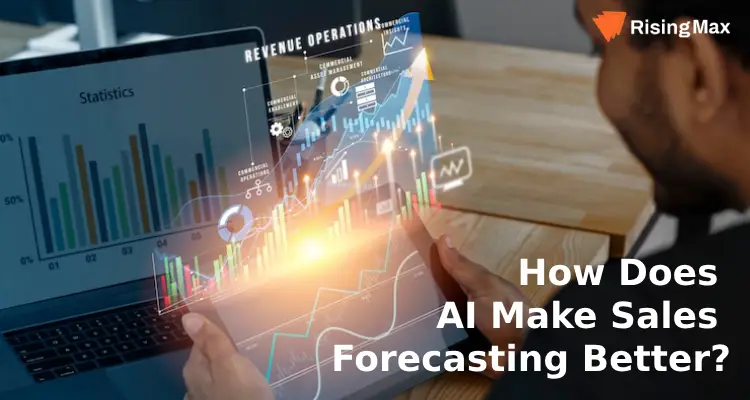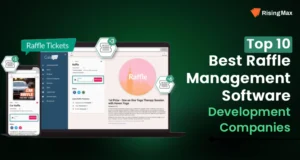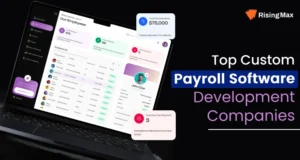Sales projection, an indelible element of any business, has traditionally been a game of educated speculating. On the other hand, this absolutely important procedure is being changed innovatively with the appearance of Artificial Intelligence (AI). In an ever-changing economic condition, correct sales forecasts are crucial for companies that aspire to grow to the next level. So far, forecasting has been a mix of art and science in which historical data, intuition, and the human brain have played a key role. On the other hand, due to the implementation of artificial intelligence (AI), automated sales forecasting has possessed extraordinary precision and insights.

The Advent Of AI In Sales Forecasting
The sales forecast is based on the sales numbers for a given period. It forecasts by means of past records, market trends, and the sales staff’s hunches. Companies use sales forecasting to run their operations and control how they allocate their resources while growing the business. Nevertheless, classic sales forecasting approaches are replete with difficulties and inaccuracies; hence, they tend to entail faulty business planning.
Through data-based insights, predictive analytics, and real-time capabilities, AI is currently making it possible for businesses to dramatically improve forecast accuracy and foresight. AI enables businesses to discern market trends and act accordingly, personalize their sales strategy, identify risks, and get maximum from their operations, resulting in a competitive edge in the fast-changing business environment. As AI grows with time, the effect of AI on sales forecasting will become more pronounced, allowing businesses to achieve better performance in a continuously evolving market.
AI in sales forecasting is changing business for good by arranging the tokens and developing the process with data justifications. AI-assisted sales forecasting uses predictive analytics based on trend analysis and data mining to discover correlations in past and present information and, hence, create a very accurate sales forecast.
Challenges With Traditional Sales Forecasting
When it comes to traditional sales forecasting techniques, some flaws are often connected with low accuracy and reliability. These include:
- Overoptimistic Predictions: Due to the necessity of attaining quotas and riding the wave of sales, teams usually produce faulty sales forecasts.
- Data Quality Issues: The quality of the input data determines the level at which departments can improve the added insights. Conversely, numerous companies stay true to their words and are always on the ground.
- Low Morale Among Sales Reps: Enthusiastic and bored sales reps who find it hard to perform their tasks might not meet their sales objectives. This gap between the sales goals and the results is delinquent.
- Unpredictable Market Conditions: The abruptness of market volatility, competition, and consumer demand affect sales, so the sales forecasting process becomes complicated and challenging.
- Unreliable Sales Cycles: The unpredictability of sales cycles is a major challenge, and a sales rep needs to incorporate several compensation models to be compensated fairly.
Optimize Your Sales Strategy Today With RisingMax’s AI Sales Forecasting Services!
Benefits Of AI In Sales Forecasting
AI is reshaping overall need estimates and allowing companies to make the best choices. AI-powered sales forecasting offers numerous benefits for businesses, including:
Data-driven Insights
AI has considerable potential, and its ability to swiftly process and analyze huge datasets is one of its possibilities. While conventional techniques may not adequately address complicated and large datasets in today’s age of digital technology, new machine learning approaches are capable of tackling such challenges. For instance, transactions are a good example, as they are structured, and you can also include chats with customers, social media, and market trends among the unstructured information.
Predictive Analytics
AI-powered forecasting includes employing improved predictive analytical techniques more than the classic mathematical models. Machine learning algorithms assist in the identification of mysterious patterns and linear relationships within the information pools: they reveal insights that are routinely missed while analyzing data manually. AI systems, using the new data, adjust and become better than earlier models, thus getting more accurate in sales forecasting.
Personalized Forecasting
AI makes it possible for organizations to use tailored and extremely personalized forecasting for certain groups or clients. By examining historical interactions and recent purchases, AI can forecast sales to a customer population, which predicts the variables that affect the will to buy each of the distinct segments of customers. This individual approach enables businesses to customize their tactics, the products offered, and warehouse management so that the target audience gets what makes them satisfied and, in turn, purchases more. An AI proposal generator can support this approach by crafting personalized sales proposals based on forecasted customer behavior and preferences.
Real-time Insights
Conventional forecasting processes frequently face the problem of a time lag between data collection and evaluation, which hinders the ability to react at the quickest possible pace to a dynamic market environment. AI eliminates this shortage by capitalizing on the current status of the situation, sales performance, and trends. Through ceaseless monitoring of the data streams and implementing predictive models in real-time, organizations are able to receive well-informed insights that assist in setting the correct prices, managing promotions, and deciding on inventory, all of which are crucial for sales success.
Risk Mitigation
On the one hand, AI tools will help forecast future sales potential on the other hand, they will identify potential risks and problems that may influence work in the future. AI models can evaluate the probability of various outcomes they face, supported by data such as economic indicators, microeconomic instability, and competition, and determine the effect of the said outcomes on sales outcomes. With these insights, businesses can develop contingency plans and anti-risk tactics to help them face precariousness, and there can be a greater level of resilience.
Integration With CRM Systems
AI-based sales prediction can work well with CRM systems by bringing together all the details about customer interaction and the sales pipeline under one umbrella. By merging sales forecasts with CRM information, businesses will attain data on customer engagement, conversion rates, and sales opportunities. In this case, the integration tools allow sales associations to prioritize leads, discover cross-selling opportunities, and steer continuous processes that boost revenue growth and enhance the bottom line.
Drive Smarter Business Decisions With AI Sales Forecasting!
Harness the power of AI for precise sales predictions and maximize revenue growth. Request a Demo to Revolutionize Your Sales Forecasting Approach!
Implementing AI For Sales Forecasting
Implementing AI in the sales forecast cloud involves a few essential steps to achieve AI adoption and collect and utilize AI technologies. By implementing such steps, companies would be able to utilize AI for sales forecasts and extract critical details. Today, sales presentations can collect data on prospects, which can be used to develop strategies that increase profitability and competitiveness in today’s business world.
Define Objectives & Key Metrics
First, to achieve this goal, make it clear and be able to replicate how you want to implement AI in sales forecasting. List the phases of the sales process that you want to intervene in and provide business analytics for the accuracy of the forecast, conversion of leads to sales, or sales revenue. Establishing an achievable target will pave the way for your plan’s implementation and will be the measure of a successful AI project.
Data Collection & Preparation
Gather the right data from different sources, such as sales transactions, customer interactions, advertising campaigns, and other market data. Maintain data quality by processing, cleaning, and organizing it for analysis. This might mean removing duplicates, handling missing data separately, and standardizing the data formats.
Select AI Technologies
Select the AI method that fits your tight goals and data type. Besides these AI techniques, salient ones used in sales forecasting are machine learning, predictive analytics, and natural language processing. Take into account some criteria, e.g., one-dimensional models and complexity, scalability, and interpretability.
Model Development & Training
Train the selected models using the AI algorithms and historical sales data. Split the data into train and validation to perform the model evaluation. Try different profiles, model architectures, and hyperbeams of parameters to enhance the forecast’s accuracy and reliability.
Integration With Existing Systems
AI anticipatory models create a stable connection with in-process sales and CRM systems for smooth data workflow and overall integration into the business process. API and middleware can galvanize factors in case data sharing between AI apps and enterprise devices is tapped into, stimulating the growth of real-time reporting for effective decision-making.
Testing & Validation
Perform comprehensive testing and validation of AI models to check their ability to deal with variable conditions. Recognize historical data and evaluate the forecasts developed by AI algorithms compared to the historical sales outcome. Weigh parameters like accuracy, precision, and recall and use the F1 score to indicate the model’s performance.
Iterative Improvement
Continuously improve the quality of the AI models by considering and applying relevant experience and practical implementation. Regularly include new data as it emerges to retrain the models and prepare for changes in the market environment dynamics. Advance the practice of modeling by repeating the development process to achieve higher accuracy, scalability, and robustness over time.
User Training & Adoption
Train and assist users who interact directly with AI-driven sales forecasting. Enlighten all sales and management teams and stakeholders on reading/analyzing a forecast, singling out key elements, and integrating AI-generated recommendations as part of their decision-making process. Allow the organization to generate an evidence-based decision-making culture to amplify the extent AI can bring to sales forecasting.
Real-world Examples Of AI For Sales Forecasting
Artificial intelligence as a sales forecasting tool is considered more of a technical phenomenon and a way that has already been applied globally with many successful results. Here are three real-world examples:
- Startups: AI can use time series analysis of the past repeated statistics of the startup’s previous sales record to calculate its future growth trends. One more advantage active tracking of their finance can bring to the table in the early stages is that founders will have a great starting point for planning and operating their business, managing resources, and strategic planning for further development.
- Businesses with Multiple Supply Chain Dependencies: A company that largely utilizes primary raw materials support or has complex and spread supply chains will possibly need AI to help it hedge its stocks and create relationships that will bear the fruits of loyalty with its trading partners.
- Businesses Facing Rapid Market Changes: AI can be an important tool for businesses in unpredictable times, such as the COVID-19 pandemic. AI assists businesses in making fast market adjustments, and its accurate sales forecasting can solve problems that businesses cannot easily predict.
Closure
Go beyond using conventional tools, algorithms, and techniques, which are highly effective in data analysis. Rather, we should look for additional ways that may lead to more accurate forecasting and greater accuracy. AI-powered sales forecasting should adopt changing trends in market conditions, customer tastes, and business needs, which will be adjusted for the right spot and performance of your business.
As AI technology for sales forecasting leads in the rear echelons, the breaks in the world of business become more and more tangible. Through information gathered by data, companies can use data-based sales forecasting to guide their business decision-making, use their resources properly, and plan strategically for growth. AI is likely to be implemented in sales forecasting, and, in my opinion, this future looks good.











